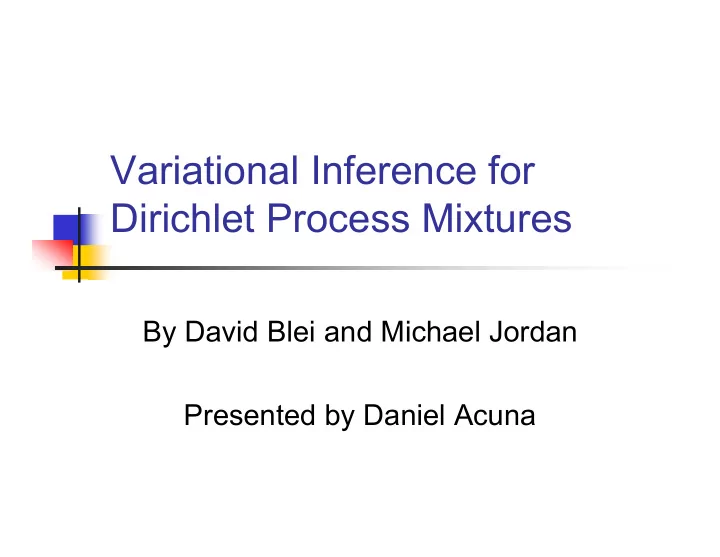

Variational Inference for Dirichlet Process Mixtures By David Blei and Michael Jordan Presented by Daniel Acuna
Motivation Non-parametric Bayesian models seem to be the right idea: Do not fix the number of mixture components Dirichlet process is an elegant and principled way to “automatically” set the components Need to explore new methods that cope intractable nature of marginalization or conditional MCMC sampling methods widely used in this context, but there are other ideas
Motivation Variational inference have proved to be faster and more predictable (deterministic) than sampling The basic idea Reformulate as an optimization problem Relax the optimization problem Optimize (find a bound of the original problem)
Background Dirichlet process mixture is a measure on measures Multiples representations and interpretations: Ferguson Existent theorem Blackwell-MacQueen urn scheme Chinese restaurant process Stick-breaking construction
exhibit a clustering effect Dirichlet process mixture model Base distribution G 0 Positive scaling parameter � { � 1 , K , � n � 1 } The DP mixture has a natural interpretation as a flexible mixture model in which the number of components is random and grows as new data are observed
Stick-breaking representation Two infinite collections of independent random variables V i ~ Beta (1, � ) For i = {1,2,…} * ~ G 0 � i Stir-breaking representation of G i � 1 � � i ( v ) = v i (1 � v j ) j = 1 � � G = � i ( v ) � � i * i = 1 G is discrete!
Sticking-breaking rep. The data can be described as arriving from Draw V i | � ~ Beta (1, � ), i = {1,2,...} 1) * | G 0 ~ G 0 i = {1,2,...} Draw � i 2) For the n-th data point 3) Draw Z n |{ v 1 , v 2 ,...} ~ Mult ( � ( v )) 1) * ) Draw X n | z n ~ p ( x n | � z n 2)
DP mixture for exponential families Observable data drawn from exponential family, the base distribution is the conjugate
Variational inf. for DP mix. In DP, our goal But complex Variational inference uses a proposal distribution that breaks the dependency among latent variables
Variational inf. for DP mix. In general, consider a model with hyperparameters , latent variables and observations x = The posterior distribution: Difficult!
Variational inf. for DP mix This is difficult Because latent variables become dependent when conditioning on observed data We reformulate the problem using the mean-field method, which optimizes the KL divergence with respect to a variational distribution .
Variational inf. for DP mix This is, we aim to minimize the KL divergence between and Or equivalently, we try to maximize the lower bound
Mean field of exponential fam. For each latent variable, the conditional is a member of a exponential family: Where is the natural parameter of w i when conditioned on the remaining latent variables Here the family of distributions is Variational parameters
Mean-field of exponential family The optimization of KL divergence after derivation (see Apendix) Notice: Gibbs sampling, we draw w i from p ( w i |w -I ,x, θ ) Here, we update v i to set it equal E[ g i ( w -I ,x, θ )]
DP mixtures The latent variables are stick lengths, atoms, and cluster assignment The hyper parameters are the scaling and conjugate base distribution And the bound now is
Relaxation of optimization To exploit this bound, with family q we need to approximate G G is an infinite-dimensional random measure. An approximation is to truncate the stick- breaking representation!
Relaxation of optimization Fix value T and q(v T = 1)=1, then are equal to zero for t>T (remember from ) Propose, Beta distributions Exponential family distributions Multinomial distributions
Optimization The optimization is performed by coordinate ascent algorithm From, Infinite!
Optimization But, Then Where
Optimization Finally, the mean-field coordinate ascent algorithm boils down to updates:
Predictive distribution
Empirical comparison
Conclusion Faster than sampling for particular problems Unlikely, that one method will dominate another both have their pros and cons This is the simplest variational method (mean-field). Other methods are worth exploring. Check www.videolectures.net
Recommend
More recommend